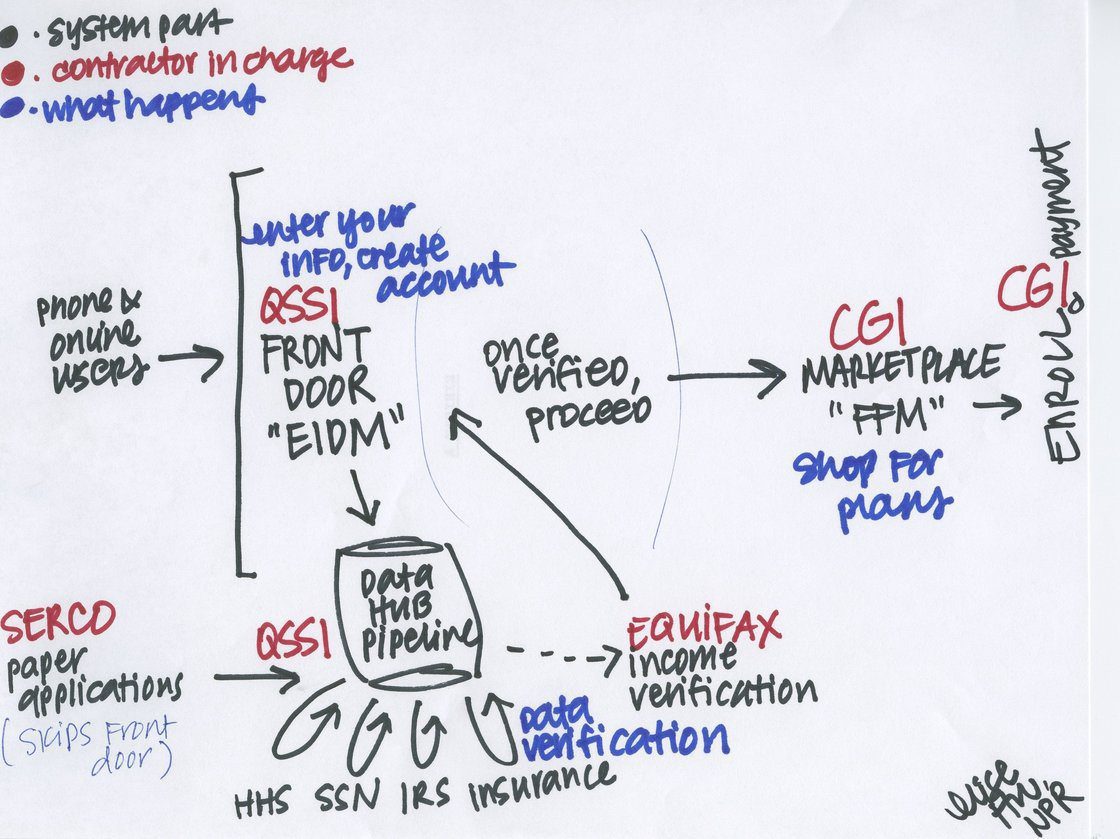
Ironically, I think that the whole uproar about the Affordable Care Act (aka Obamacare) website, healthcare.gov, could be good for business! Why? Because the issue has definitely raised the visibility of the need for senior management to be more knowledgeable about the whole online world — even the CEO. This post has no intention of commenting on the merits of universal healthcare. However, I did want to discuss why and how healthcare.gov, the crucial website at the heart of the ObamaCare system, has come out on such wobbly legs. And, as a result, I would like to take stock of the possible lessons for business.
It’s just a typical bureaucratic government problem…?
It’s slow. It bugs. It’s offline. “All I get is a red sign unexpected error, error ID and a generic response from people to keep trying…”

Those are the polite phrases regarding the healthcare.gov site. Then there are the more vitriolic versions which you can find, especially on the dedicated Facebook page. One of the regular tirades centers on the premise that “such an event would never have happened in business” or “at least in business, people are held accountable.” On the first point, this is clearly misspoken as management at United Airlines and Continental Airlines could tell you after their bungled systems and online customer service merger. But, the technological headaches abound. And many big businesses have suffered online catastrophes. Think Microsoft Vista, Grand Theft Auto or Electronic Arts’ SimCity (video games), ClickFrenzy (down under) or NASDAQ’s handling of the Facebook IPO. Even Apple, the most highly valued brand in the world, gets its launches wrong systematically. The Apple Maps app was the sorest example for them. (See this USA Today write-up)
There is plenty of precedence for making last-minute changes that wreak havoc. The MLS website launch experienced a failed launch, with echoes of the healthcare.gov last minute rejig (post by “Fake Sigi”) :
“I know how mistakes can happen, and how a radical change in web site architecture can create unforeseen issues that need to be dealt with.”
It’s just that management isn’t usually equipped or experienced enough to understand such issues. It’s simply off their radar.
In search of accountability
On the issue of accountability, we are certainly faced with a problem that is not unique to government. It’s one of the prime issues facing companies that are increasingly investing in and using digital tools and platforms. Many of these organizations operate in silos despite the need to collaborate together across departments to provide a customer-centric, value-added service.
3 major issues

Without being privy to the inner workings, from what I have read and heard, I put this catastrophic website launch down to three main issues.
- Project ownership. With nearly 60 different suppliers involved, there was clearly a lack of ownership. Needing to integrate different systems from disparate groups (IRS, Medicaid, state and local agencies, the Treasury Department and Social Security, insurance companies) was a colossal undertaking. With so many players, roles & responsibilities are bound to get blurred and accountability can easily be passed off. This is where you hear phrases such as “that’s not my issue” or “that’s beyond my remit.” It’s not that people were ill-intended or slacking off. It’s just that the roles and responsibilities were not carved out in a way that enabled Peter to talk with Paul in an effective manner. And the oversight of the entire project — outsourced to the CGI Group, even though seasoned in this type of operation — was clearly not successful.
- Lack of top brass digital understanding. This failure speaks to a poor understanding of the demand out of the gate. But, it also speaks to an often overlooked problem: infrastructure. The most obvious issue with this site is the poor dimensioning and a lack of appropriate infrastructure for the traffic. The first point is that the responsible parties obviously did not anticipate the volume of inquiries, which seems hard to imagine considering the publicity and the 180-day deadline. There were apparently 20 million visits in the first three weeks and 500,000 applications started. Secondly, they likely did not anticipate the density of inquiries caused by the simple decision to make people sign up in order to browse. Whatever testing they did, the “team” did not put itself in a position to do a beta launch, that enables inevitable kinks to be worked out. The Google lesson: it is advisable to allow for a launch, test and learn phase… giving the site the time to prelaunch, even if the break date is officially a hard date. Had upper management been more digitally savvy, maybe the decision to oblige visitors to register would have been averted (or at least compensated for)?
- Lack of clear-cut & shared objectives. This smacks of a site created without thinking about economic or business-oriented goals. We are left to wonder what types of KPIs were instituted? In government, the crossroads between different personalities, departments and constituents could be paralleled to the different personalities and silos within enterprise. In digital, in particular, companies often forgo creating clear objectives aligned with the overall business and/or providing a favorable ground for cohesion around those objectives (for example: talent, training, resources, time…).
The onslaught of comments on the Facebook page has been met with little resistance. The team’s customer service team could have been better prepared as well! Bottom line is that, as internet friendly as the top boss (President Obama) might be, the rank and file manager also need to be more savvy. In digital — just as in retail and business in general I’d add — execution is critical, if not strategic. {Click to tweet} A telltale sign about the Administration’s digital capabilities lies in the fact that Blue State Digital agency, who were responsible for the acclaimed Obama presidential online campaign, declined to bid on this project.
What to do about it?
Senior executives have a habit of “saying” that digital is important. They talk about the need to “invest in digital.” However, in reality, the movement from saying to doing digital includes being digital. {Click to tweet} Based on the lessons gleaned from the Obamacare site’s errors, below are three things that management can do as they truly attempt move from thought to digital action.
- Walk the talk. Top leadership has a habit of thinking that using and getting comfortable with the internet and social media might be beneath them. By walking the talk, there’s a better chance that, as the boss, he/she will ask the right questions. This is what I refer to as upping senior management’s Digital IQ.
- Talent. Look carefully at the talent within one’s organization and make sure that digitally savvy people are recognized. Recruitment policies should be inspected to make sure that digital savviness be part of the interview process. Training on digital (tools, platforms, policies, etc.) is vital on an ongoing basis. Ultimately, digital should not be a single person and department’s responsibility, but should be shared throughout the organization. Until is generalized, the role of Chief Digital Officer has all its sense to carry the digital message. Such a role ideally requires digital knowledge, a “2.0” mindset as well as a confirmed business acumen.
- Establish clear objectives related to the business purpose. In a large scale project, this is clearly more complex. However, this makes the simplicity and clarity of the “key” goal all the more important. In this case, (just saying) the metric might have been: time taken to sign up someone to an insurance policy?
At its core, this situation on healthcare.gov reinforces a fundamental belief I have that top management needs to get more deeply involved with three key departments: HR, IT and Customer Service.
(Pre-)Launch, Learn & Improve
Businesses are far from perfect in their digital execution and heads do not roll all the time for mistakes made, especially since it is not always obvious on who the fault lies. Digital initiatives have a way of involving many different departments, all the more so when the initiative is consumer-facing. Of course, websites of this scale are rarely rolled out to go live on Day 1. However, maybe that ambition should never have been given in the first place. In this case, they had end-to-end testing for just two weeks and it’s not clear at what point the system was tested with the last-minute integration of an obligatory log-in.
Hopefully, this Obamacare website calamity will raise eyebrows of business executives and encourage them to become more familiar and equipped to manage the digital initiatives more effectively going forward.
Your thoughts are welcome!











The father the mother the wife or the husband are always the last to know.
In the internet world the CEO is the last to know..
You are doing amazing stuff Minter and delighted to have had the chance to know you.
Best Regards
Jocelyn
The father the mother the wife or the husband are always the last to know.
In the internet world the CEO is the last to know..
You are doing amazing stuff Minter and delighted to have had the chance to know you.
Best Regards
Jocelyn
Hello Minter
Thanks for an excellent article; reminds me of one of the big projects failures in France in the recent years on a similar project called the DMP. The boss of the project was excellent (both ENA and IT experienced, an unusual combination -:) ) but he got caught in all directions by senior brass and politicians. It is project cohesion and drive but it also needs a stable governance …..funny that one tends to attribute this to private companies on both sides of the Atlantic and in France we even attribute these qualities wholesale to the USA….how wrong and reassuring in a sense !
May I add an american expression ?
If you want to eat an elephant, just go bite after bite
Hello Minter
Thanks for an excellent article; reminds me of one of the big projects failures in France in the recent years on a similar project called the DMP. The boss of the project was excellent (both ENA and IT experienced, an unusual combination -:) ) but he got caught in all directions by senior brass and politicians. It is project cohesion and drive but it also needs a stable governance …..funny that one tends to attribute this to private companies on both sides of the Atlantic and in France we even attribute these qualities wholesale to the USA….how wrong and reassuring in a sense !
May I add an american expression ?
If you want to eat an elephant, just go bite after bite